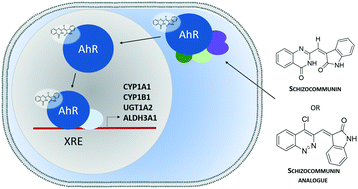Fungal natural alkaloid schizocommunin activates the aryl hydrocarbon receptor pathway
Abstract
Fungi, including mushrooms and mycelia, are a rich source for natural products with medicinal properties. In some cases, they can lead to opportunistic infections in humans and other mammals. In 1994, the first case of bronchopulmonary mycosis caused by the Schizophyllum commune fungus was described. Culture of the isolated specimen led to the extraction of an alkaloid compound, schizocommunin, which was more recently synthesised for biological characterization. Herein we describe schizocommunin and one of its analogues as cytotoxic against human hepatoma cells at low micromolar concentrations. Schizocommunin is shown to be a potent activator of the aryl hydrocarbon receptor (AhR) gene battery, more specifically increasing expression of the CYP1A1, CYP1B1 and UGT1A genes in human liver and lung cells. A luciferase reporter assay further confirms induction of transcription by these compounds at the xenobiotic response element. This study improves our understanding of the interaction between this fungal metabolite and xenobiotic detoxifying mechanisms in the body, and points to schizocommunin as a putative mediator of the allergic response and a useful molecule for the study of the AhR pathway.

- This article is part of the themed collection: Natural Products


 Please wait while we load your content...
Please wait while we load your content...